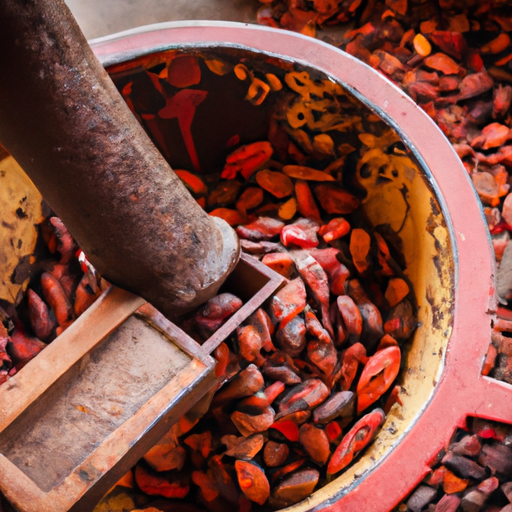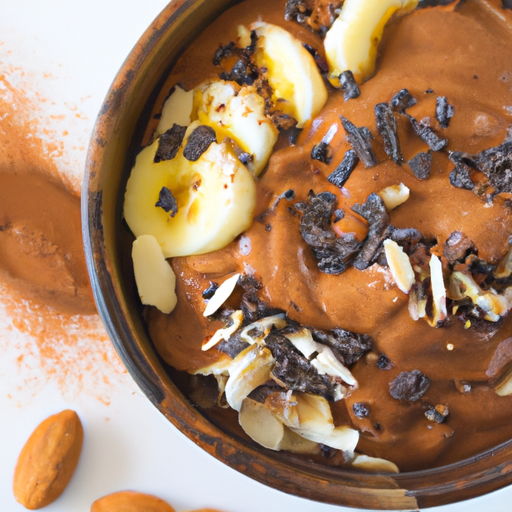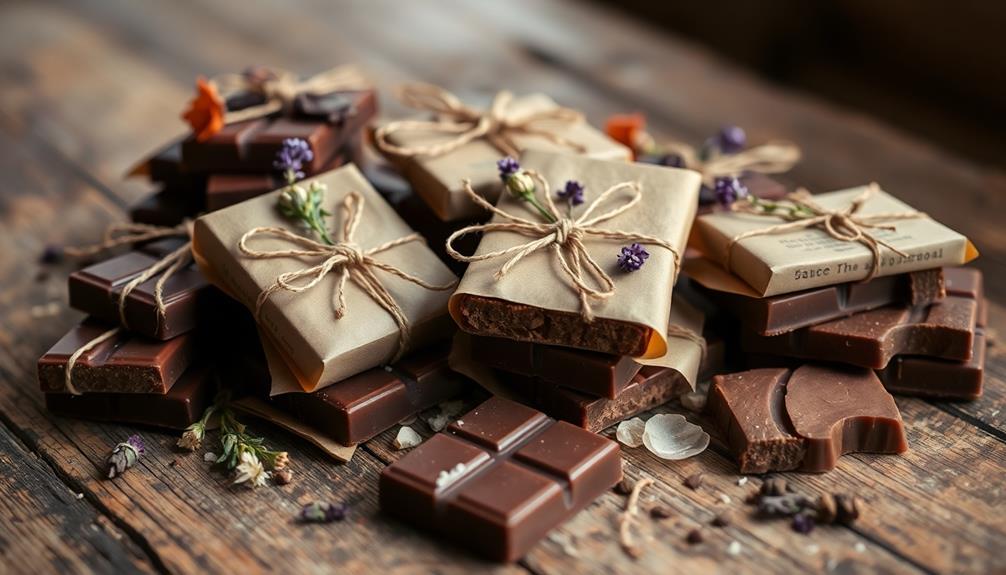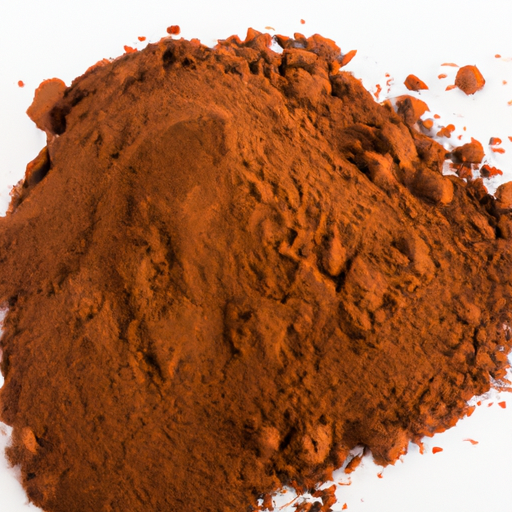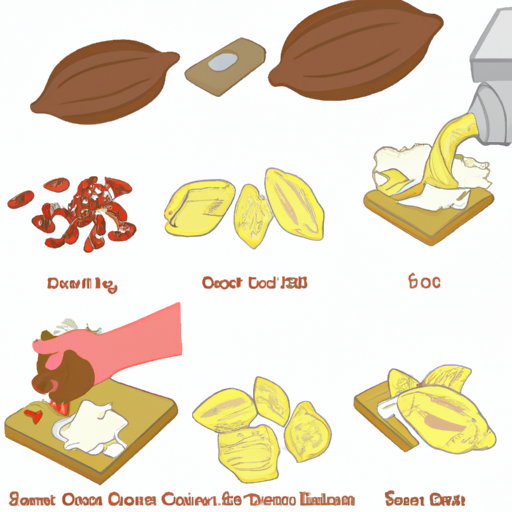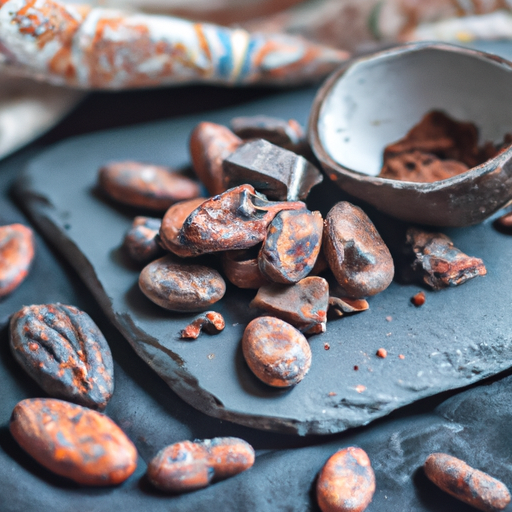Picture a voyage, in which the modest raw cacao bean undergoes a metamorphosis into the smooth, decadent treat we recognize as cocoa. This metamorphosis, akin to a mystical alchemy, includes a sequence of exacting and complex processes that reveal the genuine essence of this extraordinary ingredient.
As a food scientist, I have delved into the depths of this journey, unlocking the secrets behind each step and uncovering the science behind the flavors.
From the origins of raw cacao to the final packaging and distribution, I will guide you through the meticulous steps involved in processing this precious bean. We will explore the art of roasting the cacao beans, the grinding and winnowing process that separates the precious nibs from the husks, and the pressing of the cacao paste to extract its luscious oils.
We will dive into the conching process, where the chocolate is refined and transformed into its smooth, silky texture. And finally, we will delve into the tempering, molding, and cooling that bring the cocoa to its final form.
Join me on this fascinating journey, as we unlock the secrets of how raw cacao is processed into cocoa.
Key Takeaways
- Fermentation and drying enhance flavor.
- Roasting at precise temperatures develops cocoa aroma.
- Processing separates cocoa solids from cocoa butter.
- Refining and conching reduce bitterness and achieve smoothness.
The Origins of Raw Cacao
Take a moment to imagine yourself standing in the lush rainforests of South America. The rich soil and tropical climate give birth to the exquisite raw cacao beans that will soon be transformed into decadent cocoa.
Raw cacao has been revered for its health benefits and cultural significance in ancient civilizations.
To convert raw cacao into cocoa, a series of precise and technical processes are employed.
First, the raw cacao beans are carefully harvested and fermented to develop their distinct flavor. Then, they are dried and cleaned to remove any impurities.
Next, the beans are roasted at specific temperatures to bring out their aromas and deepen their flavors. This crucial step sets the foundation for the subsequent processes that will further transform the beans into cocoa.
Roasting the Cacao Beans
When roasting cacao beans, the first step is to enhance their flavor and aroma. This is achieved by subjecting the beans to different roasting techniques, such as low and slow roasting or high heat roasting.
Monitoring the temperature and time during the roasting process is crucial to ensure optimal flavor development and prevent over-roasting or under-roasting. By carefully controlling these variables, food scientists and technologists can achieve the desired balance of flavors and aromas in the final cocoa product.
Enhancing Flavor and Aroma
To truly elevate the taste and scent of raw cacao, artisans skillfully employ various techniques to unlock its full potential and create an unforgettable cocoa experience. These techniques include improving the fermentation process and exploring different flavor profiles.
-
Fermentation Enhancement: Artisans carefully control the temperature and duration of the fermentation process to optimize flavor development. This critical step allows the breakdown of complex compounds, releasing desirable flavor compounds and reducing bitterness.
-
Flavor Profiling: By varying fermentation conditions such as time, temperature, and microbial strains, artisans can achieve different flavor profiles in the cocoa beans. This allows for the creation of unique and distinct cocoa flavors, ranging from fruity and floral to nutty and earthy.
-
Microbial Inoculation: Some artisans introduce specific microbial strains during fermentation to enhance flavor complexity and depth. These strains can produce enzymes that further break down undesirable compounds and create desirable flavor precursors.
-
Aroma Preservation: To preserve the delicate aromas of the cocoa, artisans ensure proper drying and storage conditions. This prevents the loss of volatile aroma compounds, ensuring a rich and enticing aroma in the final cocoa product.
Moving on to different roasting techniques, let’s explore how this crucial step further enhances the flavor and aroma of cocoa.
Different Roasting Techniques
Let’s now delve into the world of different roasting techniques and discover how they enhance the flavor and aroma of our beloved cocoa.
The roasting process plays a crucial role in flavor development as it involves the Maillard reaction, which creates desirable flavor compounds.
Different roasting techniques, such as light, medium, and dark roasts, result in varying flavor profiles.
Light roasts preserve the delicate fruity and floral notes of the cacao, while medium roasts bring out more nutty and caramel flavors.
Dark roasts, on the other hand, produce a robust and bitter taste.
The duration and temperature of the roasting process also influence the flavor intensity.
Longer roasting times and higher temperatures can create deeper, more pronounced flavors.
However, excessive heat or extended roasting can lead to undesirable burnt or ashy flavors.
Monitoring temperature and time during the roasting process is crucial to achieve the desired flavor profile.
Monitoring Temperature and Time
Careful monitoring of temperature and time during the roasting process is crucial in order to achieve the desired flavor profile, ensuring that each batch of cocoa beans undergoes the transformation into a delectable treat.
The temperature range for roasting raw cacao beans typically falls between 120°C and 140°C, depending on the desired flavor and aroma. This temperature range allows for the Maillard reaction to occur, which is responsible for the development of the characteristic chocolate flavor.
Additionally, the duration of the roasting process can vary from 10 to 30 minutes, depending on the desired intensity of flavor. Consistency in temperature and time is key to ensure that each batch of cocoa beans is roasted to perfection. By maintaining consistency, the flavor and quality of the resulting cocoa can be optimized.
Moving on to the next step of the process, grinding and winnowing…
Grinding and Winnowing
First, you crack open the raw cacao beans to reveal the rich cocoa nibs inside. To transform these nibs into cocoa, the next step is grinding and winnowing. Grinding techniques involve using specialized equipment like stone grinders or ball mills to break down the cocoa nibs into a fine paste called cocoa liquor. This process requires careful control of temperature and time to prevent overheating and preserve the delicate flavors. Once the cocoa liquor is obtained, winnowing is performed to separate the husks from the cocoa solids. This is typically done using machines that apply air or vacuum to remove the lighter husks, leaving behind the valuable cocoa mass. With the husks removed, the resulting cocoa solids can then be further processed into cocoa powder or chocolate. Next, we will explore the crucial step of pressing the cacao paste to obtain cocoa butter and cocoa cake.
Pressing the Cacao Paste
To fully appreciate the richness and decadence of chocolate, you need to uncover the hidden treasures locked within the cacao paste. Pressing techniques play a crucial role in this process.
The cacao paste, obtained from grinding and winnowing, is subjected to pressing to separate the cocoa solids from the cocoa butter. Pressing involves applying pressure to the paste, which helps to extract the cocoa butter and leave behind a solid cake.
This cake is then further processed to produce cocoa powder. The benefits of pressing include the removal of excess cocoa butter, which can affect the texture and flavor of the final cocoa product. Additionally, pressing helps to enhance the homogeneity and consistency of the cocoa powder.
As we move into the subsequent section about ‘conching the chocolate,’ the pressed cocoa cake awaits its next transformation.
Conching the Chocolate
Once you’ve pressed the cacao paste, it’s time to embark on the next step of the chocolate-making journey – conching. Imagine this process as a gentle dance between the chocolate particles and the conching machine, where they swirl and mingle, transforming into a smooth and velvety treat that will melt in your mouth.
During the chocolate conching process, several key transformations occur. Here are five important aspects to consider:
- Frictional heat generated in the conching machine helps melt and distribute cocoa butter evenly.
- The continuous agitation breaks down large particles, resulting in a finer texture.
- Acidic compounds naturally present in cocoa are neutralized, reducing bitterness and enhancing flavor.
- The conching time and temperature are carefully controlled to optimize the texture and flavor development.
- Volatile compounds are evaporated, improving the aroma and removing any undesirable flavors.
By understanding and optimizing the conching process, we can create chocolate with the perfect balance of smoothness, flavor, and aroma.
Now, let’s transition to the subsequent section about tempering the chocolate.
Tempering the Chocolate
After conching the chocolate, the next crucial step in the process of converting raw cacao into cocoa is tempering. Tempering is a technique that involves carefully controlling the temperature of the chocolate to ensure it has the desired texture, appearance, and shelf life.
The importance of temperature control cannot be overstated, as it allows for the formation of stable cocoa butter crystals within the chocolate. This is achieved by gradually cooling and reheating the chocolate to specific temperatures, which encourages the proper crystallization and alignment of the cocoa butter.
Tempering techniques can vary, but common methods include seeding and tabling. These techniques require precise monitoring of temperatures, typically between 80-90°F (27-32°C), to achieve the desired results.
The successful tempering of chocolate is essential for creating a smooth, glossy finish and preventing the formation of unwanted fat bloom.
Moving on to the subsequent section about molding and cooling…
Molding and Cooling
When molding and cooling chocolate, the first step is pouring the melted chocolate into molds. This is done carefully to ensure that the chocolate fills each mold evenly and without any air bubbles.
Once poured, the chocolate is left to set at room temperature or placed in a cooling chamber to accelerate the process.
Cooling and solidifying the chocolate is crucial as it allows the cocoa butter to harden and gives the final product its desired texture and appearance.
This process requires precise temperature control to prevent any crystallization issues and achieve the desired glossy finish.
Pouring the Chocolate into Molds
To achieve the desired shape, carefully pour the luscious chocolate into the molds, using precision and expertise in the shaping process. The temperature of the chocolate must be closely monitored to ensure it is at the optimal level for pouring, typically around 86°F to 90°F (30°C to 32°C).
The chocolate is poured into the molds using a ladle or a specialized pouring device, ensuring that each mold is filled evenly. Once filled, the molds are gently tapped on a surface to remove any air bubbles and to ensure that the chocolate settles evenly.
After pouring, the molds are transferred to a cooling chamber, where the chocolate is allowed to cool and solidify into delectable cocoa treats. This cooling process typically takes around 20 to 30 minutes.
Once the chocolate has set, it can be easily removed from the molds, ready to be packaged and enjoyed.
Allowing the Chocolate to Set
Once the chocolate has hardened, it’s time to savor the anticipation of biting into a perfectly formed, mouthwatering treat. Allowing the chocolate to set is a crucial step in the process of transforming raw cacao into cocoa.
Food scientists and technologists experiment with different textures and techniques to achieve the desired consistency and flavor. This process involves carefully controlling the temperature and humidity levels to ensure proper crystallization of the cocoa butter. By manipulating these factors, they can influence the final texture of the chocolate, whether it be smooth and creamy or firm and snappy.
Additionally, the time duration for allowing the chocolate to set can vary depending on the specific recipe and desired outcome. It is essential to strike the right balance between allowing enough time for the chocolate to solidify and preventing over-crystallization.
With the chocolate now set, it’s time to move on to the next step: cooling and solidifying the chocolate further.
Cooling and Solidifying the Chocolate
After allowing the chocolate to set, the next step in the process of converting raw cacao into cocoa is cooling and solidifying the chocolate. This step is crucial in achieving the desired texture and consistency of the final cocoa product.
Cooling techniques are employed to rapidly lower the temperature of the chocolate, causing it to solidify. This can be done using specialized cooling tunnels or refrigeration units, which maintain precise temperatures and airflow to ensure even cooling.
As the chocolate cools, the cocoa butter within it crystallizes, resulting in a smooth and glossy appearance. The rate at which the chocolate solidifies can affect its final texture, so it is important to carefully control the cooling process.
Once the chocolate has solidified, it is ready for the next stage of packaging and distribution.
Packaging and Distribution
Packaged in vibrant, eye-catching boxes and shipped to chocolate lovers worldwide, the rich and velvety cocoa undergoes a meticulous distribution process.
Utilizing packaging innovations and efficient logistics, the goal is to ensure that every package of cocoa reaches its destination in perfect condition.
Advanced techniques such as vacuum sealing and temperature-controlled storage are employed to preserve the quality and flavor of the cocoa.
Global distribution networks are established to meet the demand from various regions, with careful consideration given to environmental factors, transportation routes, and delivery timelines.
Additionally, collaboration with retailers and online platforms helps to make the cocoa readily available to consumers.
By prioritizing quality control and efficient distribution, the industry strives to provide chocolate enthusiasts with a satisfying and enjoyable experience.
Enjoying the Finished Product
Savoring the final product, chocolate lovers around the world relish in the indulgent velvety texture and rich flavors that dance on their taste buds.
The journey from raw cacao to cocoa involves several crucial steps that contribute to the delightful experience.
Firstly, the raw cacao beans are fermented and dried to enhance their flavor profile. Then, they undergo roasting at precise temperatures to develop the characteristic cocoa aroma.
Next, the roasted beans are ground into a paste, known as cocoa liquor, which is further processed to separate the cocoa solids from the cocoa butter. This stage involves pressing the cocoa liquor to extract the cocoa butter, leaving behind the cocoa powder.
Lastly, the cocoa powder is refined and conched to achieve the desired smoothness and reduce any remaining bitterness. The result is a fine cocoa powder that can be used in various culinary creations, allowing chocolate enthusiasts to fully enjoy the taste and reap the health benefits of cocoa.
Frequently Asked Questions
What are the health benefits of consuming raw cacao?
Consuming raw cacao has numerous health benefits. It is rich in antioxidants, fiber, and minerals such as magnesium and iron. Its high nutrition content can support cardiovascular health, improve mood, and boost cognitive function.
Can raw cacao be used in baking recipes?
Raw cacao can be used in baking, but there are pros and cons. Pros include rich flavor and potential health benefits, while cons include bitterness and potential texture issues. Alternatives to raw cacao in baking recipes include cocoa powder or chocolate chips.
How does the flavor of raw cacao differ from processed cocoa?
The flavor profile of raw cacao differs from processed cocoa due to the absence of roasting, which preserves its natural fruity and bitter notes. Additionally, raw cacao retains higher nutritional value with more antioxidants, vitamins, and minerals.
What are some common uses for cocoa powder?
Cocoa powder is commonly used in baking and drinks. It adds a rich, chocolatey flavor and a dark color to recipes. From chocolate cakes to hot chocolate, cocoa powder enhances the taste and appearance of many delicious treats.
How does the quality of raw cacao affect the final chocolate product?
The quality of raw cacao greatly impacts the final chocolate product. Factors such as raw cacao sourcing and the fermentation process can affect the flavor, aroma, texture, and overall quality of the cocoa.
How Is Raw Cacao Processed and How Can I Use It to Make Cocoa at Home?
Raw cacao in Brevard County is typically processed by fermenting, drying, roasting, and grinding the cacao beans. To make cocoa at home, simply grind the raw cacao beans into a powder and mix with hot water or milk. Add sweetener to taste and enjoy a homemade cup of rich, chocolatey cocoa.
Conclusion
In conclusion, the process of converting raw cacao into cocoa is a precise and technical endeavor. As a food scientist, I have examined the origins of raw cacao and the steps involved in roasting, grinding, pressing, conching, tempering, molding, and packaging.
Each step requires specific temperatures, time durations, and chemical reactions. It is crucial to adhere to industry standards and scientific research to ensure the highest quality cocoa.
Through analytical and critical thinking, we can continue to improve and innovate in the processing of raw cacao, always striving for excellence.
Remember, as the adage goes, "With precision and expertise, cocoa is transformed, bringing joy to those who indulge."
"With every meticulous step and relentless pursuit of perfection, we unlock the true essence of cocoa, crafting an unparalleled delight that captivates the senses and brings blissful moments to all who savor its decadence."

